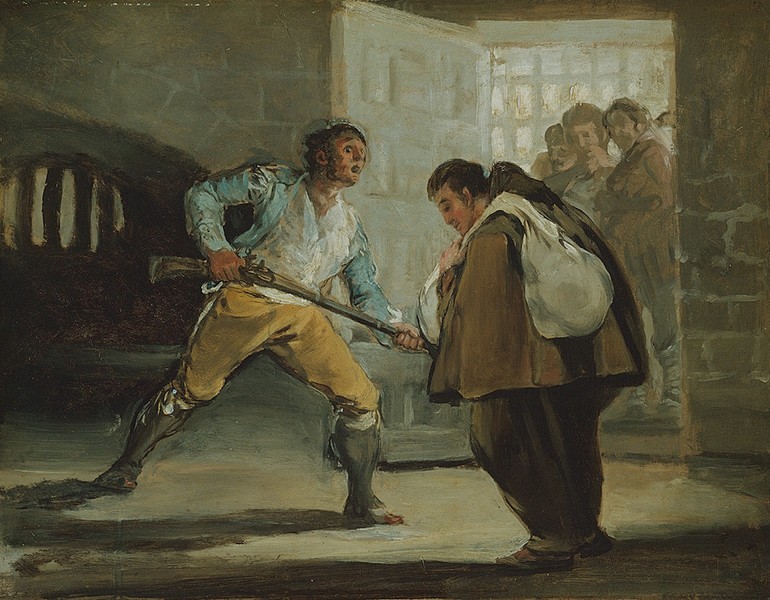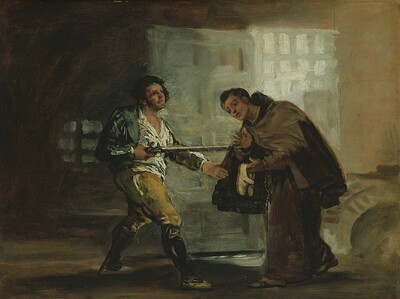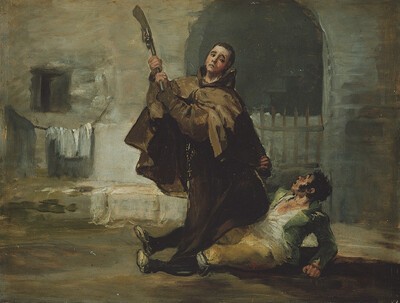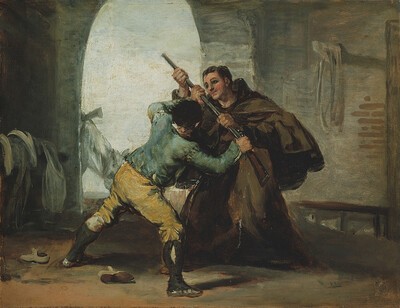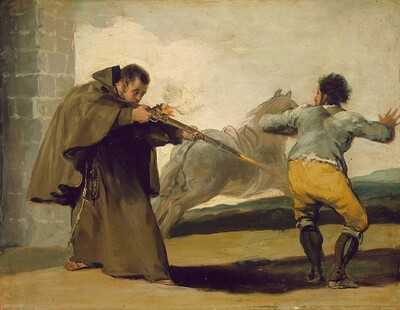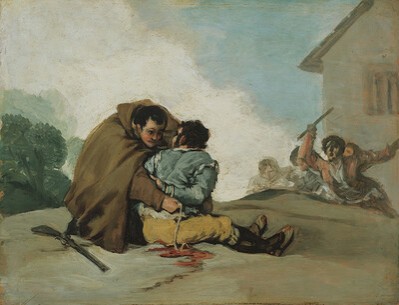- Cronología
- 1806 - 1807
- Ubicación
- The Art Institute of Chicago, Chicago, United States
- Dimensiones
- 29.2 x 38.5 cm
- Técnica y soporte
- Oil on wood panel
- Reconocimiento de la autoría de Goya
- Documented work
- Titular
- The Art Institute of Chicago
- Ficha: realización/revisión
- 01 Mar 2010 / 14 Jun 2023
- Inventario
- (1990. 558)
Goya produced this series of six paintings to record the celebrated capture of the bandit "El Maragato". They stayed in his possession, as reflected in the inventory drawn up on the death of Josefa Bayeu in 1812, and were then inherited by Javier Goya.
On 7 March 1861 the Laffite collection to which the paintings belonged was put up for sale at the Hotel Drouot in Paris (lot no. 34), but they remained unsold until 1911 when they were acquired by Julius Böhler from Munich. Until 1928 they belonged to the collection of Martin A. Ryerson of Chicago, who donated them to the Art Institute of Chicago in 1933.
The story of the dreaded Pedro Piñero, better known as "El Maragato" captured the public's imagination when Friar Pedro de Zaldivia managed to escape from harm's way and capture him on 10 June 1806. The bandit had been condemned to death for his crimes, although his punishment had been substituted for forced labour in the armoury of Cartagena, where he was taken in 1804. He managed to escape, and he reached the west of Toledo, seizing arms and committing further robberies on the way. On the day of his capture, he had entered a house in El Verdugal in Oropesa, where Friar Pedro arrested the fugitive. He was sent to Madrid, where he was hung and quartered on 18 August. The religious man's exploits were made known in poems and popular prints. Goya also had a part in this dissemination with his cycle of six paintings on panel, designed as a predella altarpiece, compared on some occasions to a film storyboard.
This set of images reflects a change in Goya's view on society and the world. There is a distancing from his previous works depicting elegant dandies and picaresque young gentlemen and women. Popular realism can already be traced in Goya's work, even before the Napoleonic invasion. The Maragato and Friar Pedro de Zaldivia cycle represents the most brutal depiction of the people produced by Goya prior to the works directly linked to the War of Independence.
In order to follow every detail of the events of that morning in June, it is important to take into account the leaflet published in Madrid a month later. Goya used it as a source for the design of these scenes, although these display many alterations which suggest that the works were carried out in a rather spontaneous, even experimental way. The setting, sketchy in its execution, is different for each panel, since the artist adapted it to the figures of the two protagonists, who are precisely drawn and full of energy and spontaneity. The result is a series of images with a strong popular feel and touches of humour, interspersed with the great dramatic moments and gestures appropriate to historical painting.
This first image in the series portrays the meeting between the bandit and the monk, in the moment when the criminal has imprisoned the members of the household in a room and seized the chief guard's horse. El Maragato threatens the monk with his rifle before imprisoning him with the others in a room. We can see the door of that room in the background, the captives peering in from the doorway.
-
Spanish Paintings from El Greco to GoyaThe Metropolitan Museum of ArtNew York1928consultant editor Bryson Borroughs. From February 17th to April 1st 1928cat. 7
-
The art of Goya. Paintings, drawings and printsThe Art Institute of ChicagoChicago1941from January 30th to March 2nd 1941cat. 71
-
GoyaKoninklijk Kabinet van Schilderijen MauritshuisThe Hauge1970organized by Ministerio de Estado y Asuntos Culturales and Réunion des Musées Nationaux, July 4th to September 13th 1970. Exhibited also at the Musée de l’Orangerie des Tuileries, Paris, October 25th to December 7th 1970, consultant editors Jeannine Baticle and A. B. de Vriescat. 33
-
Goya. El Capricho y la Invención. Cuadros de gabinete, bocetos y miniaturasMuseo Nacional del PradoMadrid1993from November 18th 1993 to February 15th 1994. Exhibited also at the Royal Academy of Arts, London, March 18th to June 12th 1994 and The Art Institute of Chicago, Chicago, July 16th to October 16th 1994, consultant editors Manuela B. Mena Marqués and Juliet Wilson-Bareaucat. 84
-
Goya: Prophet der ModerneAlte NationalgalerieBerlin2005from July 13th to October 3th 2005. Exhibitied also at the Kunsthistorischemuseum, Vienna, October 18th 2005 to January 8th 2006, consultant editor Manuela B. Mena Marquéscat. 88
-
Noticia exacta de todo lo executado por Pedro Piñero, alias el Maragato, desde que se escapó de presidio, hasta que fue preso y herido por el Padre Fray Pedro de Valdivia, religioso lego de la Orden de San Pedro de Alcántara [Madrid, 1806]reimp. Imprenta de la calle de la Cintería1806
-
L'œuvre peint de Goya. 4 volsParís1928-1950vol. I, p. 244, cat. 215
-
Cómo vivía GoyaArchivo Español del Arte1946p. 86, 106
-
Goya’s source for the Maragato seriesGazette des Beaux-Arts1958pp. 298-304
-
Vie et ouvre de Francisco de GoyaParísOffice du livre1970vol. III, p. 183
-
BarcelonaPolígrafa1970vol. I, p. 331, cat. 511
-
L’opera pittorica completa di GoyaMilanRizzoli1974p. 120, cat. 456
-
Francisco de Goya, 4 vols.ZaragozaCaja de Ahorros de Zaragoza, Aragón y Rioja1980-1982vol, III, p. 155 y p. 200 (il.)
-
Goya. El capricho y la invención. Cuadros de gabinete, bocetos y miniaturasMadridMuseo del Prado1993pp. 292-293, 376, cat. 84
